Disa graminifolia
Disa graminifolia Ker Gawl. ex Spreng.
Family: Orchidaceae
Common names: blue disa (Eng.), bloumoederkappie (Afr.)
Introduction
Disa graminifolia is one of the most attractive, and less known orchid species. It has violet-blue flowers in late summer to early autumn that catch one’s attention in dense fynbos vegetation and captivate with their enchanting fragrance reminiscent of sweet nectar.
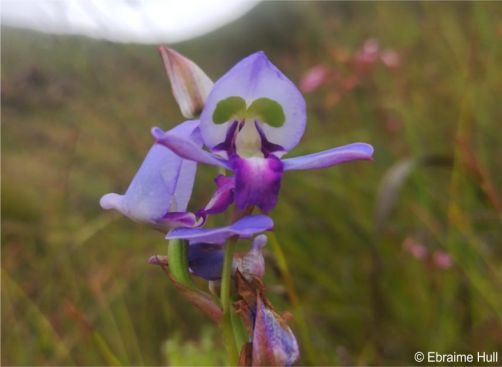
Description
Description
Disa graminifolia is a slender, deciduous terrestrial orchid with a tuberous rootstock, typically growing to height of about 600 mm. It produces grass-like leaves in autumn so that they are present during the winter rainy season while the plant is in active growth. The leaves die back when the rains stop, in spring to early summer, and are absent during the summer dry season. It follows an unusual growth rhythm, producing its flowers towards the end of the dry season, in late summer to autumn, when its leaves are usually absent. It produces 2–6 violet-blue flowers in a lax raceme at the tip of the flower stalk. Disas have a unique floral structure that plays a crucial role in the orchid’s reproductive strategy, facilitating interactions with pollinators and ensuring successful seed dispersal. This flower is made up of 3 sepals and 3 petals. The sepals are blue and make up the outer part of the flower; the upper sepal forms the hood that encloses the flower, and 2 lateral sepals, 13–15 mm long, form the downward curving oblong wing-like structures on each side of the flower. Inside the hood are the 3 dark blue to violet and white petals. The 2 upper petals are underneath the hood and each have a green, kidney-shaped tip. The dark purple lower petal, called the lip, curves downward. The white structure in the centre of the flower is the column, with the stigma at the base and the pollinaria at the top. At the back of the hood, on the outside of the flower, there is a 2–4 mm long, club-shaped spur. Flowering time is in late summer and autumn, from January to March. This orchid flowers erratically, and often skips a year between flowering. Also, when it does produce flowers then it does not produce leaves in the following growing season. And then no flowers will appear but leaves will be produced the following winter.
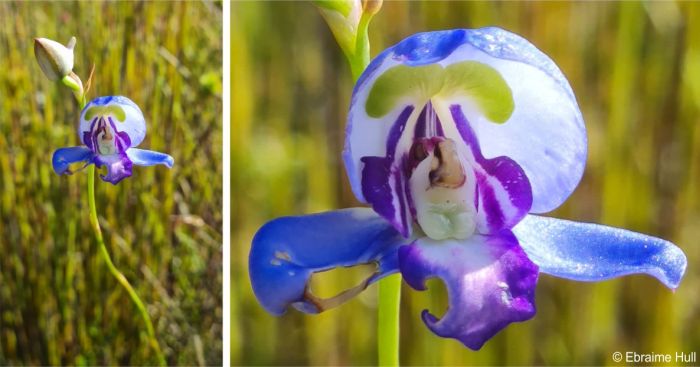
Disa graminifolia can easily be confused with Disa purpurascens, but they can be told apart by the shape of their spur and lip: the spur of Disa purpurascens is cone-shaped and its lip curls upwards compared to that of Disa graminifolia whose spur is club-shaped (thicker at the tip than the base) and its lip curls downward. Also, Disa purpurascens flowers earlier, in spring to early summer (October to November).
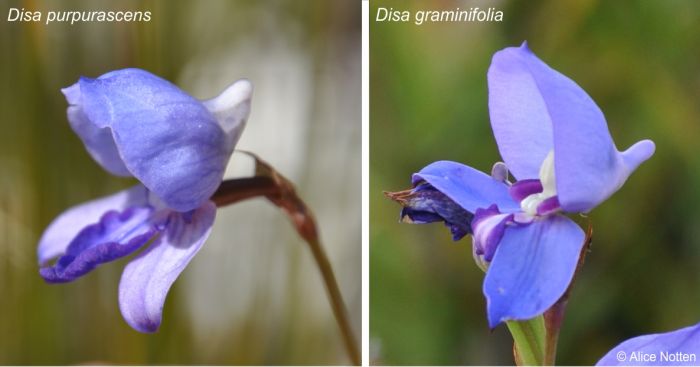
Conservation Status
Status
According to the Red List of South African Plants, this plant’s status is currently Least Concern (LC), it is not threatened and has a stable population. All South African orchids are protected species and may not be collected from the wild without a permit. Disas are listed on CITES and may not be traded internationally without a CITES permit.
Distribution and habitat
Distribution description
This species is endemic to South Africa and is found only in two provinces, the Eastern Cape and Western Cape. This orchid grows on dry, sunny, coastal, sandstone slopes from the Cape Peninsula to Gqeberha, between 300–1 000 m altitude. The species thrives in mountain fynbos vegetation, which is a unique type of heathland vegetation native to the Western Cape.
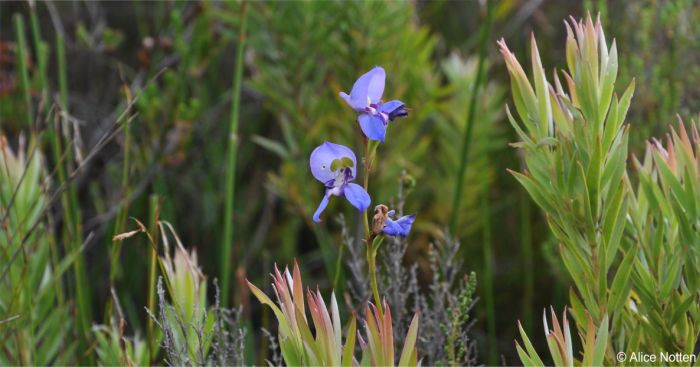
Derivation of name and historical aspects
History
The origin of the genus name Disa is not known. Börge Pettison believes the plant was named after Queen Disa whose story is told in a Swedish legendary saga. The botanist who named the genus, Peter Jonas Bergius, was Swedish. The species name graminifolia originates from Latin, with gramin denoting ‘grass’ and folia meaning ‘leaves’. This name aptly describes Disa graminifolia’s foliage, which resembles delicate blades of grass. This species was previously placed in the genus Herschelia which was established for the blue-flowered disas and named after the astronomer Sir John Herschel (1792–1871). The Afrikaans name bloumoederkappie, meaning ‘blue mother’s bonnet’ refers to the hooded shape of the flower which resembles the bonnets worn by Dutch women in olden days.
Ecology
Ecology
Adding to its sensory appeal, Disa graminifolia emits a delightful fragrance, reminiscent of sweet nectar, which serves to attract potential pollinators. Among these visitors are carpenter bees, drawn to the vivid blue hues of the orchid’s blooms. While searching for nectar the bee pushes against the column and the pollinaria become attached to its thorax. However, it mistakes the flowers for a viable nectar source, because they don’t produce any nectar, and these industrious insects inadvertently aid in the orchid’s pollination efforts, contributing to its reproductive success but do not get any reward from the flower.
The seeds are tiny, dust-like and are dispersed by wind. The seedlings need to form a symbiotic association with a mycorrhizal fungus present in the soil in its habitat, in order to obtain nutrients for them to survive. Mycorrhizal fungi are beneficial fungi that colonise the roots of a plant and supply the plant with minerals and in return receive sugars from the plant.
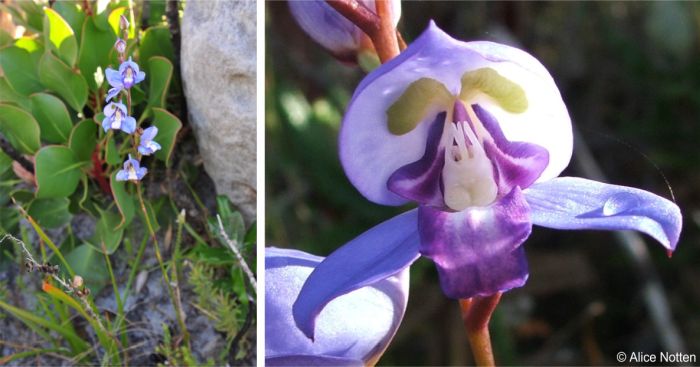
Uses
Use
Although there are no records of cultural or medicinal uses for Disa graminifolia, orchids carry cultural significance across various societies, particularly in South Africa, where they feature in local folklore, cultural rituals and are used in traditional medicine to treat various ailments.
Disa graminifolia garners horticultural interest for its aesthetic appeal. Orchid enthusiasts and collectors may cultivate this species for its exquisite flowers, adding to the diversity of cultivated orchid varieties. Additionally, Disa graminifolia's unique growth habits and specialized adaptations make it a difficult garden subject but one of interest for botanical gardens, where it can be showcased to the public for educational and conservation purposes. Please remember that disas are protected plants that may not be removed from the wild without the appropriate permits.
Growing Disa graminifolia
Grow
Disa graminifolia is best grown in terracotta pots, which provide optimal drainage and aeration for its root system. Despite its stunning appearance, maintaining this orchid over an extended period can prove to be a challenging endeavour. Best results are obtained when cultivators recreate the conditions in its natural habitat, and incorporate some soil and organic matter sourced from its native environment into the growing medium. This meticulous attention to detail is crucial for ensuring the health and vigour of the plant in cultivation. Incorporating soil from its natural habitat into the growing medium not only provides essential nutrients but also helps to mimic the unique microorganisms and symbiotic relationships present in its native ecosystem. This approach aims to create a harmonious environment that closely resembles the conditions in which Disa graminifolia thrives in the wild.
Disa graminifolia is difficult to propagate, and difficult to keep alive in containers.
Plants can be propagated from seed, although it is very difficult for the home gardener to successfully do so. In habitat, the tiny seeds need to land on suitable soil to be able to form associations mycorrhizae in the soil to obtain nutrients in order to survive. In the nursery they need to be sown under sterile, laboratory conditions on specially formulated growth medium that contains the correct mycorrhizal fungus. To obtain seeds in a garden or laboratory situation, the flowers must be hand-pollinated, by taking pollen from one flower and placing it on the stigma of a different flower. Harvest the capsule as it begins to split and allow it to dry and release the seeds.
Clump-forming disas can be propagated by division. When the daughter plants are fully established, lift the plant just before the growing season begins, in late summer (March). Handle with care, use clean, sterilized tools, gently separate the offsets, and replant immediately in soil that contains the correct mycorrhizal fungus.
Disa graminifolia requires a sandy, acidic growth medium, preferably with some soil from its habitat included. The recommended procedure is to place a 2–3 cm layer of acidic well-rotted compost (such as pine needle compost) at the bottom of the container, and fill up the container with a soil mix of 3 parts coarse, washed river sand mixed with 1 part soil from the habitat (or river sand mixed with habitat soil). Place the container in a position that gets morning sun and afternoon shade or bright light for most of the day. Place it in a protected position that is sheltered from heavy rain and strong wind, and that gets good ventilation, such as a house with open sides and an opaque roof. They should not be allowed to overheat.
Leave the plants in the soil during the dormant period, allow the soil to dry out and store the container in a cool, dry place. Do not lift the tubers, they desiccate very easily and will perish.
Begin watering when the first leaf shoots appear towards the end of autumn. Give them a heavy drench, every 7–10 days and allow the soil to almost dry out completely before the next watering. Use slightly acidic water or rain water, or water that is free of dissolved salts. Tap water should be allowed to stand for 3 hours for the chlorine to evaporate. As soon as the leaves begin to wither, water less frequently and when the plant is dormant let the soil dry out and keep it dry during summer and place the containers in a cool, dry spot.
Feed with hydroponic or liquid organic fertiliser at half the recommended rate, once a month during the active growth period.
References
- Burman, l. & Bean, A. 1985. Hottentots Hollands to Hermanus. South African Wild Flower Guide 5. Botanical Society of South Africa, Cape Town.
- Casabio. Disa graminifolia. https://casabio.org/taxa/disa-graminifolia. Accessed on 20/05/2024.
- Chinsamy, M., Finnie, J.F. & Van Staden, J. 2010. The ethnobotany of South African medicinal orchids. South African Journal of Botany 77:2–9.
- Crous, H. & Duncan, G. 2006. Grow disas. Kirstenbosch Gardening Series. National Botanical Institute, Cape Town.
- Fernkloof Nature Reserve. Disa graminifolia. https://www.fernkloof.org.za/index.php/all-plants/plant-families/item/disa-graminifolia. Accessed on 20/05/2024.
- Latti, I. n.d. Disa graminifolia. Operation Wildflower. Online. https://www.operationwildflower.org.za/index.php/albums/genera/disa/disa-graminifolia-neville-attridge-1-2415. Accessed on 20/05/2024.
- Manning, J. & Goldblatt, P. 2012. Plants of the Greater Cape Floristic Region 1: the Core Cape Flora. Strelitzia 29. South African National Biodiversity Institute, Pretoria.
- Manning, J. 2007. Field guide to Fynbos. Struik Publishers, Cape Town.
- Raimondo, D., Von Staden, L., Foden, W., Victor, J.E., Helme, N.A., Turner, R.C., Kamundi, D.A. & Manyama, P.A. (eds) 2009. Red list of South African plants. Strelitzia 25. South African National Biodiversity Institute, Pretoria.
- Smith, C.A. 1966. Common names of South African plants. Memoirs of the Botanical Survey of South Africa No. 35. Government Printer, Pretoria.
- Wikipedia. Mycorrhiza. https://en.wikipedia.org/wiki/Mycorrhiza. Accessed 23/06/24.
Credits
Lubanzi Kutshwa, Harold Porter National Botanical Garden
and Alice Notten, Kirstenbosch National Botanical Garden
July 2024
Acknowledgements: the authors thank Miss Caroline Marima, Horticulturist at Harold Porter National Botanical Garden for assisting with the article and Mr. Ebraime Hull, Garden and Nursery Supervisor at Harold Porter National Botanical Garden, for providing images.
Plant Attributes:
Plant Type: Orchid
SA Distribution: Eastern Cape, Western Cape
Soil type: Sandy
Flowering season: Late Summer
PH: Acid
Flower colour: Blue, Purple, White
Aspect: Morning Sun (Semi Shade)
Gardening skill: Challenging
Special Features:
Horticultural zones








Rate this article
Article well written and informative
Rate this plant
Is this an interesting plant?
Login to add your Comment
Back to topNot registered yet? Click here to register.